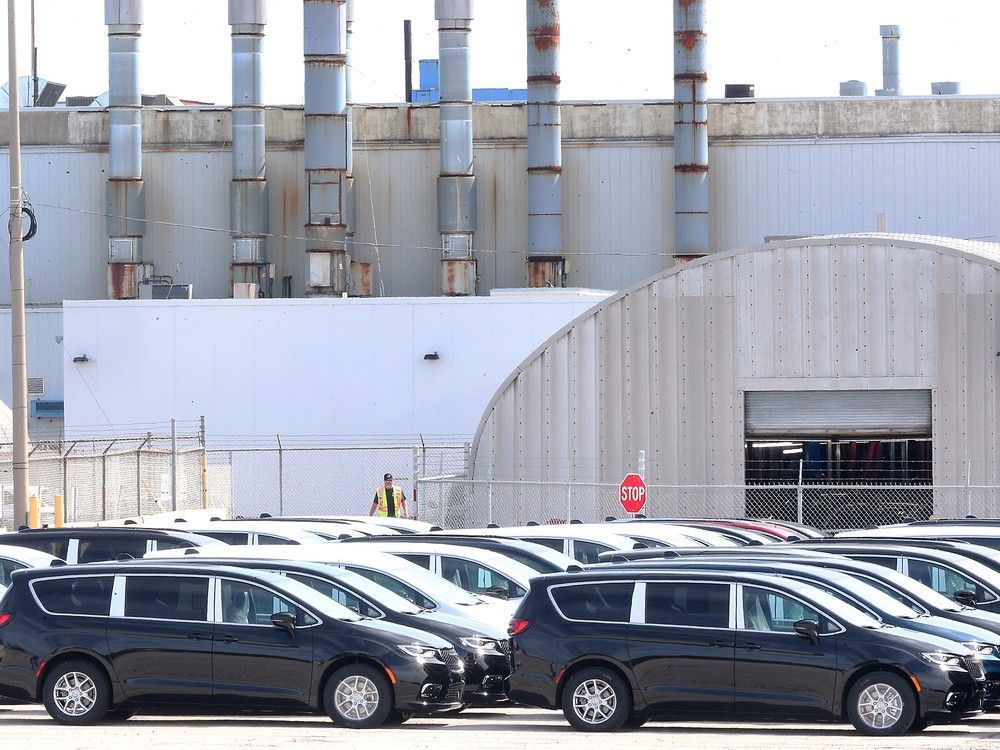
As the global trade war grinds on, the economic uncertainty has put the North American auto sector on pace to produce half a million fewer vehicles this year, according to an industry observer.
And U.S. President Donald Trump’s tariffs fight is also putting kinks in the industry’s supply chains that are now resulting in some plant closures or reduced production, says Sam Fiorani, vice-president of global vehicle forecasting with AutoForecast Solutions.
As part of that, Fiorani told the Star, “we’re starting to see some production issues related to access to rare earth minerals.”
A chunk of that overall production loss is being felt by Canadian workers with Stellantis’s Windsor Assembly Plant having endured production slowdowns this spring and the Brampton Assembly Plant auto production having paused for retooling.
“This year we’re looking at production dropping by about 500,000 units compared to last year in North America,” said Fiorani. “We’re (on pace for) just under 14.9 million vehicles. Last year, we hit 15.379 million vehicles.”
Ford’s two Windsor engine plants are running full bore, but the Oakville Assembly Plant is still being retooled for F-series truck production.
General Motors has idled its CAMI plant in Ingersoll and it’ll be reduced to one shift when it returns to production in October. GM is also using a fluctuating production schedule at Oshawa Assembly and plans to eliminate the plant’s third shift in October.
Brampton is of particular concern to the Canadian industry as there are worries an entire plant, not just a shift, could become a casualty of the tariff war.
“It’s unlikely that they’ll make any major announcements (on Brampton) before an agreement between the U.S. and Canada happens,” Fiorani said. “Any pre-emptive acknowledgement of new product coming out of Brampton could work against the negotiations.”
Stellantis has some wiggle room when it comes to timelines on Brampton, which is expected to produce the new generation Jeep Compass, Fiorani added. He said the company may have tipped its hand on how it will handle that announcement by how long it delayed announcing details of the new Jeep Cherokee to be produced in Mexico.
“The plan for the current Compass is another one-and-a-half years of production in Mexico,” Fiorani said. “There’s some space there.
“Using the Cherokee as a sign, they could wait until at least next summer as how late they could possible make the announcement.
“The Cherokee is hitting volume production in October and they announced it in June, which for a manufacturer is really late.”
Stellantis has given no indication it plans to shift the new Compass production from Brampton.
Stellantis Canada’s head of communications Lou Ann Gosselin told the Star on June 4 the company will have an announcement soon about Brampton.
“Our plan is still to return it to a two-shift operation,” said Gosselin, who wouldn’t offer an estimate on when that announcement might come.
“The Compass is an important product,” Fiorani said.
“This is the entry level model in the Jeep lineup and the Stellantis lineup for North America. They’re going to need to continue to have that product in the lineup.
“The company’s shift upmarket has not been the best move, abandoning entry-level buyers. If the last model of Compass disappears, even for a little while, it’s a bad sign to buyers that there’s no room for them if they’re looking for something under $40,000.”
Fiorani said the Detroit 3 automakers are under the Trump administration’s microscope and each is behaving differently based on their footprint in North America.
GM imported more vehicles into the U.S. than any other automaker in 2024.
It imported 750,000 vehicles built in Canada and Mexico, with Mexico providing the bulk of those. Though not all Silverados built in Oshawa were exported, that Ontario plant manufactured 151,000 vehicles while GM’s CAMI plant produced 3,500 BrightDrop electric vans.
GM imported another 475,000 vehicles from its plants in South Korea (420,000) and China (55,000).
Fiorani said that vulnerable position made this month’s announcement by GM on investing $4 billion in its U.S. plants a political one as much as a production decision.
“They seemed to have been under the gun from the Trump administration,” Fiorani said.
“With so much production, especially in Mexico, they needed to show some signs that they have investment plans for the U.S.
“Shifting some product around, and product that should’ve been shifted anyway in some cases, it helps their negotiating stance.”
Fiorani said Ford and Stellantis have larger footprints than GM in Canada and substantial production in Mexico, though not to GM’s level.
However, Stellantis has three new products being launched in Mexico in the next 12 months — the Wagoneer S, the Recon and the Cherokee.
“They’re going to need to stay under the radar unless they have a shift they can tout as really positive and one that makes sense for longer than just the term of one president,” Fiorani said.
“They’ve (Stellantis) already announced enough things (mid-sized truck) for Belvedere (Illinois), but unless they have something they really want to move or showcase something they’ve done in the U.S., they’re going to be very quiet.”
Related
Fiorani said the impact of the U.S.’s global trade disputes are now being felt in the supply chains. The inability to get some parts and critical minerals is playing havoc with some plants.
“The Ford Explorer plant in Chicago lost about a week to a shortage of components and we’re seeing some numbers that look like other plants are having problems,” Fiorani said.
“Although nothing has trickled out specifically that it’s a parts problem, we have located a few production lines that didn’t come in last month as high as they should have.
“We’re still tracking down if that’s a demand issue or a supply chain issue.”
Twitter.com/winstarwaddell